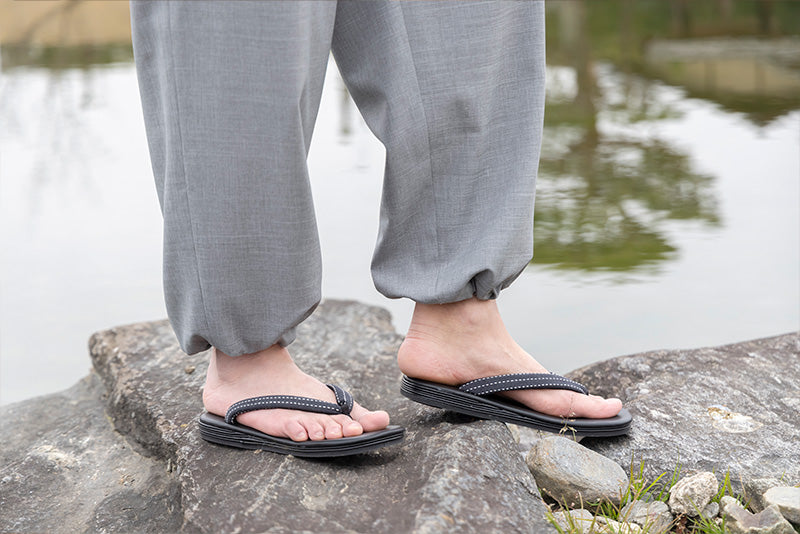
Samue (Samui) was originally worn by Zen monks as their work clothes. "samu /作務" refers to the
chores
at the temple, and "e (i) / 衣" means clothing. Today, many artisans as well as people in the general
public wear samue for a variety of uses.
Samue
Collection

The jinbei originated from haori worn by samurai in the Warring States period, becoming popular
among common people during the Edo period. It is a perfect summer garment with great ventilation and
breathability.
Jinbei
Collection

Hanten is a traditional coat that has been worn by common people since the Edo period. The padding
between the outer and inner layers provides excellent heat retention, making it warm and comfortable
for the cold seasons.
Hanten
Collection

Haori was originally worn for warmth as well as a decorative item to show one's status during the
Warring States period. Its shape and materials have changed over time and now, people wear haori
casually and also in formal situations.
Haori

Zudabukuro was a bag that monks would hang from their necks when collecting alms and storing
Buddhist altar equipment. Nowadays, it is also used as a fashionable accessory that goes well with
Japanese and Western clothing.
Bags

Kiryu-ori has a history dating back to the Nara period (710-784) and is produced mainly in Kiryu
City, Gunma Prefecture where WASUIAN's physical store is located. Its high-quality and traditional
craftsmanship is highly regarded.
Kiryu-ori

Sashiko-ori is a traditional Japanese handicraft in which cloth is stitched with a needle to
reinforce the fabric, retain heat, and create a decorative pattern. The fabric is durable yet has a
gentle texture. It is used in judo and kendo uniforms.
Sashiko

Shijira-ori is said to have been accidentally invented by a woman living in Tokushima. Because of
the “shibo” (creases ), there are fewer areas that touch the skin than plain weave, so it is more
breathable and can help keep you cool in hot temperatures.
Shijira

Enshu-ori is produced in Shizuoka, starting from the Edo period. The fabrics have a gentle texture
and a unique feel that becomes more familiar every time you use them. They are also used at the
world's top fashion shows.
Enshu-ori

This is a type of fabric that is woven with strong twists in the weft, and is made usually from silk
or hemp. The natural creases in the fabric release heat, so it is often used for summer kimono.
Chijimi

Tsumugi is a strong fabric that is originally woven from thread and made by hand-spinning raw silk
from defective cocoons that do not produce silk. It is characterized by its simple patterns and
gentle texture.
Tsumugi

Nanako literally translates to “fish eggs.” It’s called this because the surface of the fabric woven
in plain weave resembles the pattern of fish eggs. The fabric is soft, shiny, durable, and highly
resistant to wear and tear.
5055 Nanako-ori
Samue

The technique of kasuri originated in India and was introduced to Japan in the 7th -8th century.
Kasuri refers to textiles with a distinctive faded pattern. From the Meiji period until the 1960s,
many people wore kasuri kimono on a daily basis.
Kasuri

It is the strongest natural fiber with excellent sweat absorption, good breathability, and quick
drying properties, which make the fabric excellent at cooling you down. In Japan, it has been used
not only for clothing but also for Shinto rituals and traditional performing arts since ancient
times.
Hon’asa

Kakishibu has long been used as paint, dye, and medicine, taking advantage of the bactericidal, and
antiseptic effects of tannin. When applied to fabrics, it creates a tough film on the surface of the
fibers, making them stronger and also waterproof.
Kakishibu

Yoryu means “willow leaf.” The name comes from the creases on the surface of the fabric that
resemble a willow leaf. The fabric has less contact with the skin, excellent sweat absorption, and
breathability, making it comfortable to wear.
Yoryu

Bushu (Saitama Prefecture) is especially famous for indigo dyeing. It is characterized by the dye
made from naturally fermented indigo leaves, and the subtle texture of the hand-dyeing, which
becomes more beautiful as it fades.
Bushu

This fabric was introduced from India, which was originally called “Tenjiku” in Japanese. The
plain-woven cotton fabric is characterized by its light and thin qualities, as well as its good
breathability, pleasant texture, and excellent sweat absorption.
3092 Tenjiku
Samue Underwear

The word “Hijiri” means “sacred” or “saint” in English. In Japan, it originally meant a monk of high
virtue.
Hijiri

KAIHARA’s denim fabrics are recognized worldwide. KAIHARA applies the techniques that have been
cultivated in traditional kasuri patterns to denim production and now is the largest denim fabric
manufacturer on the market in Japan.
KAIHARA

Sen no Rikyu (1522-1591), a tea master, invented setta. He made sandals that guests would wear on
snowy days to tea ceremonies more comfortable by attaching leather, making them waterproof and
keeping out the cold.
Setta

Geta are traditional Japanese footwear with three holes called “me” (eye) through which the strap is
threaded, and a stilt at the bottom called "ha” (tooth) for making contact with the ground.
Geta
